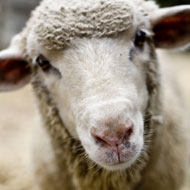Udder research offers new insights

A leading cause of udder lumps was found to be acute mastitis.
A ewe mastitis research project has offered fresh insights into the risk factors for udder lumps and acute mastitis.
The findings could help to inform culling decisions and improve awareness of the conditions that cause udder lumps.
Researchers from the University of Warwick scored nearly 5,000 pedigree and commercial ewes over two breeding seasons.
In two consecutive years, the ewes were scored four weeks before lambing and nine weeks after giving birth.
Acute mastitis was found to be more common in ewes with poor udder conformation, teat lesions, inadequate nutrition during pregnancy and those feeding twins or triplets.
Older ewes were also more likely to have acute mastitis.
Ewes with the condition were also found to be "significantly more likely" to have an udder lump in the next examination.
Leading causes of udder lumps were found to be acute mastitis, teat lesions, infection by another ewe and feeding insufficient energy during lactation.
Furthermore, researchers found flocks with a higher percentage of ewes with lumps during pregnancy had a higher number of ewes with lumps in lactation. Senior livestock scientist Liz Genever said this suggests the infection is passed within the flock.
Udder lumps are formed by bacteria and can rupture and disperse, reforming as another abscess elsewhere in the udder.
A link was found between udder conformations (big/extremely positioned teats and droopy udders) and an increase in teat lesions, udder lumps, acute mastitis and slower growing lambs.
The final report from the project is expected to be released later this year.



 The veterinary mental health charity Vetlife is inviting the veterinary community to join it for a sponsored cold-water dip.
The veterinary mental health charity Vetlife is inviting the veterinary community to join it for a sponsored cold-water dip.